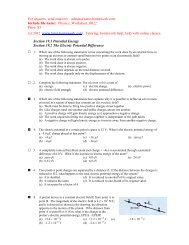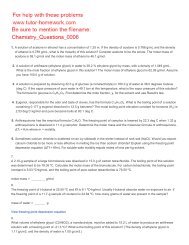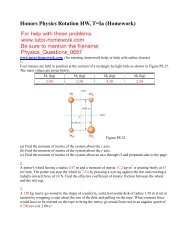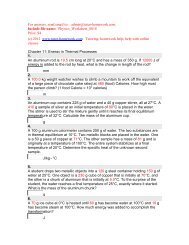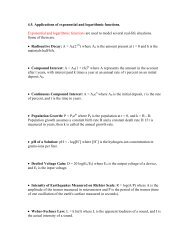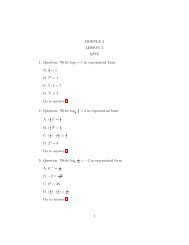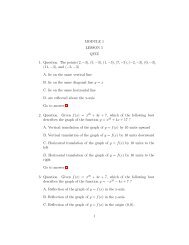Section 1 - Tutor-Homework.com
Section 1 - Tutor-Homework.com
Section 1 - Tutor-Homework.com
Create successful ePaper yourself
Turn your PDF publications into a flip-book with our unique Google optimized e-Paper software.
chapter<br />
SPECIAL RELATIVITY<br />
www.tutor-homework.<strong>com</strong> (for tutoring, homework help, or help with online classes)<br />
<strong>Section</strong> 28.1 Events and Inertial Reference Frames<br />
<strong>Section</strong> 28.2 The Postulates of Special Relativity<br />
<strong>Section</strong> 28.3 The Relativity of Time: Time Dilation<br />
1. At time t = 2.3 s, a 4-kg block that initially moves with a constant speed of 6 m/s undergoes an<br />
inelastic collision with another block. Any two inertial observers must agree that<br />
(a) the event took place at t = 2.3 s.<br />
(b) the initial speed of the block is 6 m/s.<br />
(c) the initial momentum of the block has magnitude 24 kg m/s.<br />
(d) the second block is moving after the collision.<br />
(e) the momentum of the two block system is conserved during the collision.<br />
3. Which one of the following is a consequence of the postulates of special relativity?<br />
(a) There is no such thing as an inertial reference frame.<br />
(b) Newton's laws of motion apply in every reference frame.<br />
(c) Coulomb's law of electrostatics applies in any reference frame.<br />
(d) The question of whether an object is at rest in the universe is meaningless.<br />
(e) The value of every physical quantity depends on the reference frame in which it is measured.<br />
5.<br />
Jasmine is moving in a spaceship at a constant velocity away from a group of stars. Which<br />
one of the following statements indicates a method by which she can determine her absolute<br />
velocity through space?<br />
(a) She can measure her increase in mass.<br />
(b) She can measure the contraction of her ship.<br />
(c) She can measure the vibration frequency of a quartz crystal.<br />
(d) She can measure the change in total energy of her ship.<br />
(e) She can perform no measurement to determine this quantity.<br />
6.<br />
7.<br />
Which one of the following statements concerning the proper time interval between two events is true?<br />
(a) It is the longest time interval that any inertial observer can measure for the event.<br />
(b) It is the shortest time interval that any inertial observer can measure for the event.<br />
(c) It is the time measured by an observer who is in motion with respect to the event.<br />
(d) Its value depends upon the speed of the observer.<br />
(e) Its value depends upon the choice of reference frame.<br />
Which one of the following statements concerning time dilation is true?<br />
(a) Time dilation is predicted by special relativity, but has never been observed.<br />
(b) Time dilation has been observed only in experiments involving radioactive decay processes.<br />
(c) Time dilation has been observed in experiments involving both atomic clocks and radioactive<br />
decay processes.<br />
(d) Time dilation was demonstrated by the Michelson-Morley experiment.
Physics, 7e TEST BANK 287<br />
(e) Time dilation has been disproved in experiments with atomic clocks.<br />
8. Which one of the following statements is a consequence of Special Relativity?<br />
(a) Clocks that are moving run slower than when they are at rest.<br />
(b) The length of a moving object is larger than it was at rest.<br />
(c) Events occur at the same coordinates for observers in all inertial reference frames.<br />
(d) Events occur at the same time for observers in all inertial reference frames.<br />
(e) The speed of light has the same value for observers in all reference frames.<br />
9. Two helium-filled balloons are released<br />
simultaneously at points A and B on the x axis in<br />
y<br />
an earth-based reference frame. Which one of<br />
the following statements is true for an observer<br />
moving in the +x direction?<br />
(a) The observer always sees the balloons<br />
released simultaneously.<br />
(b) The observer could see either balloon<br />
A<br />
B<br />
released first depending on her speed and the distance between A and B.<br />
(c) The observer sees balloon A released before balloon B.<br />
(d) The observer sees balloon B released before balloon A.<br />
(e) The observer cannot determine whether they were released separately or simultaneously.<br />
x<br />
10. In the year 2100, an astronaut wears an antique, but accurate, “quartz" wristwatch on a<br />
journey at a speed of 2.0 10 8 m/s. According to mission control in Houston, the trip lasts<br />
12 hours. How long was the trip as measured on the watch?<br />
(a) 6.7 hr (c) 12.0 hr (e) 21.6 hr<br />
(b) 8.9 hr<br />
(d) 16.1 hr<br />
11. In a science fiction novel, a starship takes three days to travel between two distant space stations<br />
according to its own clocks. Instruments on one of the space stations indicate that the trip took four<br />
days. How fast did the starship travel, relative to the space station?<br />
(a) 1.98 10 8 m/s (c) 2.51 10 8 m/s (e) 2.99 10 8 m/s<br />
(b) 2.24 10 8 m/s<br />
(d) 2.83 10 8 m/s<br />
12. The proper mean lifetime of a muon is 2.2 10 6 s. A beam of muons is moving with speed 0.6c<br />
relative to an inertial observer. How far will a muon in the beam travel, on average, before it decays?<br />
(a) 288 m (c) 500 m (e) 800 m<br />
(b) 360 m<br />
(d) 600 m<br />
13. A bomb is designed to explode 2.00 s after it is armed. The bomb is launched from earth and<br />
accelerated to an unknown final speed. After reaching its final speed, however, the bomb is<br />
observed by people on earth to explode 4.25 s after it is armed. What is the final speed of the<br />
bomb just before it explodes?<br />
(a) 0.995c (c) 0.939c (e) 0.882c<br />
(b) 0.971c (d) 0.904c<br />
14. During a baseball game, a batter hits a ball directly back to the pitcher who catches it. An observer<br />
flying over the stadium at a speed of 0.75c, measures 0.658 s as the time between the two events<br />
(hitting and catching the ball). What is the proper time interval between the two events?<br />
(a) 0.288 s (c) 0.658 s (e) 0.994 s<br />
(b) 0.435 s<br />
(d) 0.715 s<br />
15. A spaceship traveling at 0.8550c relative to the Earth monitors a motorcycle drag race on Earth.
288 Chapter 28 Special Relativity<br />
The space travelers measure the time from the start to the finish of the race to be 14.46 s. What is<br />
the proper time interval for the motorcycle race?<br />
(a) 7.499 s (c) 10.22 s (e) 27.90 s<br />
(b) 8.348 s<br />
(d) 14.46 s<br />
<strong>Section</strong> 28.4 The Relativity of Length: Length Contraction<br />
17. Complete the following statement: To measure the proper length of an object moving relative to<br />
the surface of the earth, one must note the coordinates of points on the front and back ends<br />
(a) at the same time with respect to a clock at rest on the earth.<br />
(b) at different times with respect to a clock on the moving object.<br />
(c) at the same time with respect to a clock on the moving object.<br />
(d) at different times with respect to a clock at rest on the earth.<br />
(e) at the same time with respect to a clock moving at the same speed on the surface of the earth.<br />
18. Which one of the following statements concerning the proper length of a meter stick is true?<br />
(a) The proper length is always one meter.<br />
(b) The proper length depends upon the speed of the observer.<br />
(c) The proper length depends upon the acceleration of the observer.<br />
(d) The proper length depends upon the reference frame in which it is measured.<br />
(e) The proper length is the length measured by an observer who is moving with respect to the<br />
meter stick.<br />
19. A meter stick is observed to be only 0.900 meters long to an inertial observer. At what speed,<br />
relative to the observer, must the meter stick be moving?<br />
(a) 0.44 10 8 m/s (c) 0.95 10 8 m/s (e) 2.70 10 8 m/s<br />
(b) 0.57 10 8 m/s<br />
(d) 1.31 10 8 m/s<br />
20. A UFO flies directly over a football stadium at a speed of 0.50c. If the proper length of the field is<br />
100 yards, what field length is measured by the crew of the UFO?<br />
(a) 59 yards (c) 87 yards (e) 121 yards<br />
(b) 75 yards<br />
(d) 113 yards<br />
21. A spaceship leaves our solar system at a constant speed of 0.900c and travels to a point in the<br />
Andromeda galaxy. According to astronomers in an inertial reference frame on Earth, the distance to<br />
the galaxy is 2.081 10 22 m. What distance does the crew on the ship measure on its journey?<br />
(a) 9.07 10 21 m (c) 1.91 10 22 m (e) 4.77 10 22 m<br />
(b) 9.85 10 21 m<br />
(d) 2.83 10 22 m<br />
22. The Milky Way galaxy is a part of a group of galaxies called the Local Group. The proper distance<br />
from the Milky Way, on one side of the Local Group, to the M31 galaxy on the other side is<br />
approximately 2.4 10 6 light-years. How long (in years) would it take a spaceship traveling at 0.999c<br />
to travel this distance according to travelers onboard?<br />
(a) 2.4 10 6 years (c) 1.1 10 5 years (e) 2.0 10 4 years<br />
(b) 8.4 10 5 years<br />
(d) 5.6 10 4 years



